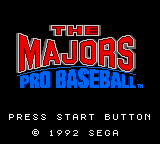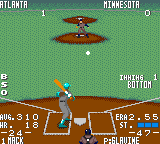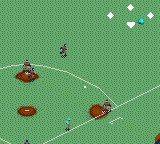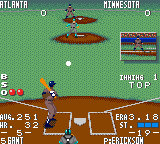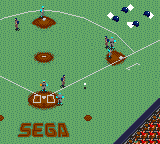Difference between revisions of "The Majors: Pro Baseball"
From Sega Retro
(tabs) |
|||
| Line 16: | Line 16: | ||
'''''{{PAGENAME}}''''' is a baseball game for the [[Sega Game Gear]] released exclusively in North America. | '''''{{PAGENAME}}''''' is a baseball game for the [[Sega Game Gear]] released exclusively in North America. | ||
| − | The game has a [[wikipedia:Major League Baseball|Major League Baseball]] license but not the team licenses, so all of the players and cities from the | + | The game has a [[wikipedia:Major League Baseball|Major League Baseball]] license but not the team licenses, so all of the players and cities from the 1991 season are represented but none of the team names or logos appear. It was succeeded by ''[[World Series Baseball (Game Gear)|World Series Baseball]]'' in 1993. |
==Gameplay== | ==Gameplay== | ||
| − | The game follows the rules of | + | The game follows the rules of Major League Baseball. Players can choose from any of the 26 teams from the [[wikipedia:1991 Major League Baseball season|1991 MLB season]], plus the American League All-Stars and National League All-Stars ("dream teams" consisting of the best players from each league) and up to two custom teams created by the player. The game has the following modes: |
*'''Exhibition:''' An exhibition mode, for playing a single game against the computer. The player selects a team to play as well as a team to play against (which can be the same team). | *'''Exhibition:''' An exhibition mode, for playing a single game against the computer. The player selects a team to play as well as a team to play against (which can be the same team). | ||
| Line 28: | Line 28: | ||
Before each game, players can choose a pitcher and create a batting line-up by ordering the starting members or swapping reserve players. Players also choose the length of the game (from 3, 5, 7, or a full 9 innings) and the stadium (the White Star Dome, Blue Sky Stadium, or Red Sky Stadium). Player one is the visiting team and bats first. | Before each game, players can choose a pitcher and create a batting line-up by ordering the starting members or swapping reserve players. Players also choose the length of the game (from 3, 5, 7, or a full 9 innings) and the stadium (the White Star Dome, Blue Sky Stadium, or Red Sky Stadium). Player one is the visiting team and bats first. | ||
| − | {{InfoTable|imagewidths= | + | {{InfoTable|imagewidths=240| |
{{InfoRow | {{InfoRow | ||
| title=Defense | | title=Defense | ||
| screenshot=The Majors Pro Baseball, Pitching.png | | screenshot=The Majors Pro Baseball, Pitching.png | ||
| screenshot2=The Majors Pro Baseball, Fielding.png | | screenshot2=The Majors Pro Baseball, Fielding.png | ||
| + | | tabs=yes | ||
| desc=All pitcher/batter confrontations use the same perspective from behind the umpire (with corresponding directional controls). When pitching, use {{left}} and {{right}} to position the pitcher on the mound. Throw the ball with {{2}}; use {{left}} and {{right}} for a breaking ball, {{up}} to throw a change-up (slow pitch), or {{down}} to throw a fastball. Faster pitches are harder for the batter to hit but more likely to travel farther or potentially result in a home run. The batter is eliminated when three strikes are thrown; the batter gets a free base if the pitcher throws four balls or hits the batter. | | desc=All pitcher/batter confrontations use the same perspective from behind the umpire (with corresponding directional controls). When pitching, use {{left}} and {{right}} to position the pitcher on the mound. Throw the ball with {{2}}; use {{left}} and {{right}} for a breaking ball, {{up}} to throw a change-up (slow pitch), or {{down}} to throw a fastball. Faster pitches are harder for the batter to hit but more likely to travel farther or potentially result in a home run. The batter is eliminated when three strikes are thrown; the batter gets a free base if the pitcher throws four balls or hits the batter. | ||
| Line 43: | Line 44: | ||
| screenshot=The Majors Pro Baseball, Hitting.png | | screenshot=The Majors Pro Baseball, Hitting.png | ||
| screenshot2=The Majors Pro Baseball, Running.png | | screenshot2=The Majors Pro Baseball, Running.png | ||
| + | | tabs=yes | ||
| desc=When hitting, the D-Pad positions the batter in the batter's box. Swing with {{2}}; the batter stops the swinging motion when the button is released. Square up a bunt by holding {{1}}+{{2}}; the batter can be moved around while holding the bunt. The player can instruct a baserunner to lead-off by holding a direction corresponding to a base ({{right}} for first, {{up}} for second, {{left}} for third, or {{down}} for home) and pressing {{1}} or steal a base by holding a direction and also holding {{1}}. | | desc=When hitting, the D-Pad positions the batter in the batter's box. Swing with {{2}}; the batter stops the swinging motion when the button is released. Square up a bunt by holding {{1}}+{{2}}; the batter can be moved around while holding the bunt. The player can instruct a baserunner to lead-off by holding a direction corresponding to a base ({{right}} for first, {{up}} for second, {{left}} for third, or {{down}} for home) and pressing {{1}} or steal a base by holding a direction and also holding {{1}}. | ||
Revision as of 02:29, 24 January 2023
| The Majors: Pro Baseball | ||||||||||
|---|---|---|---|---|---|---|---|---|---|---|
| System(s): Sega Game Gear | ||||||||||
| Publisher: Sega | ||||||||||
| Developer: I.T.L | ||||||||||
| Licensor: Major League Baseball Players Association | ||||||||||
| Peripherals supported: Gear-to-Gear Cable | ||||||||||
| Genre: Sports | ||||||||||
| Number of players: 1-2 | ||||||||||
|
The Majors: Pro Baseball is a baseball game for the Sega Game Gear released exclusively in North America.
The game has a Major League Baseball license but not the team licenses, so all of the players and cities from the 1991 season are represented but none of the team names or logos appear. It was succeeded by World Series Baseball in 1993.
Contents
Gameplay
The game follows the rules of Major League Baseball. Players can choose from any of the 26 teams from the 1991 MLB season, plus the American League All-Stars and National League All-Stars ("dream teams" consisting of the best players from each league) and up to two custom teams created by the player. The game has the following modes:
- Exhibition: An exhibition mode, for playing a single game against the computer. The player selects a team to play as well as a team to play against (which can be the same team).
- Pennant: Plays a season of 32, 71, or a full 162 games against computer-controlled teams. The game cartridge stores the player's progress so it can be continued at any time.
- Versus Play: The two-player mode, allowing two players to play a game against each other over a Gear-to-Gear Cable. Player one decides the length of the game and the stadium.
- Edit: Allows the player to create up to two custom teams composed of any of the players from any of the teams in the game. The teams are stored on the cartridge and can be played in Exhibition Mode.
Before each game, players can choose a pitcher and create a batting line-up by ordering the starting members or swapping reserve players. Players also choose the length of the game (from 3, 5, 7, or a full 9 innings) and the stadium (the White Star Dome, Blue Sky Stadium, or Red Sky Stadium). Player one is the visiting team and bats first.
Teams
| League | Division | Team | Based on |
|---|---|---|---|
| American | Western | Minnesota | Minnesota Twins |
| Chicago A. | Chicago White Sox | ||
| Texas | Texas Rangers | ||
| Oakland | Oakland Athletics | ||
| Seattle | Seattle Mariners | ||
| Kansas City | Kansas City Royals | ||
| California | California Angels | ||
| Eastern | Toronto | Toronto Blue Jays | |
| Boston | Boston Red Sox | ||
| Detroit | Detroit Tigers | ||
| Milwaukee | Milwaukee Brewers | ||
| New York A. | New York Yankees | ||
| Baltimore | Baltimore Orioles | ||
| Cleveland | Cleveland Indians | ||
| National | Western | Atlanta | Atlanta Braves |
| Los Angeles | Los Angeles Dodgers | ||
| San Diego | San Diego Padres | ||
| San Francisco | San Francisco Giants | ||
| Cincinnati | Cincinnati Reds | ||
| Houston | Houston Astros | ||
| Eastern | Pittsburgh | Philadelphia Phillies | |
| St. Louis | St. Louis Cardinals | ||
| Philadelphia | Detroit Tigers | ||
| Chicago N. | Chicago Cubs | ||
| New York N. | New York Mets | ||
| Montreal | Montreal Expos |
Magazine articles
- Main article: The Majors: Pro Baseball/Magazine articles.
Physical scans
| Sega Retro Average | ||||||||||||||
|---|---|---|---|---|---|---|---|---|---|---|---|---|---|---|
|
| 71 | |
|---|---|
| Based on 2 reviews | |
Technical information
ROM dump status
| System | Hash | Size | Build Date | Source | Comments | |||||||||
|---|---|---|---|---|---|---|---|---|---|---|---|---|---|---|
| ? |
|
256kB | Cartridge (US) | 128B backup |
References
| The Majors: Pro Baseball | |
|---|---|
|
Main page | Magazine articles | Reception | |
| Sega-published baseball games for the Sega Game Gear | |
|---|---|
| The Pro Yakyuu '91 (1991) | Hyper Pro Yakyuu '92 (1992) | Pro Yakyuu GG League (1993) | Pro Yakyuu GG League '94 (1994) | Tatakae! Pro Yakyuu Twin League (1995) | |
| The Majors: Pro Baseball (1992) | |
